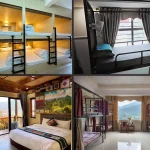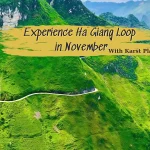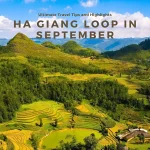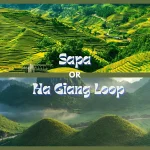Nestled in the mountains of Northern Vietnam, Du Gia is a hidden gem on the Ha Giang Loop. This tranquil village, surrounded by breathtaking landscapes and rich in cultural heritage, offers a unique escape from the usual tourist trails. In the article, let’s explore this serene destination with Karst Plateau.
1. Introduction to Du Gia in Ha Giang
1.1 Location of Du Gia

Strolling on the narrow roads between the fields, you will feel the peace and quiet of this land
Nestled in the Yen Minh district of Ha Giang province, Du Gia is approximately 300 kilometers north of Hanoi. This remote commune can be accessed via the Ha Giang Loop, a thrilling route known for its breathtaking views of rugged mountains, valleys, and vibrant green rice fields. The journey to Du Gia is an adventure in itself, as travelers can traverse winding roads that reveal ever-changing landscapes, offering a feast for the eyes and a balm for the spirit.
The geographical position of Du Gia makes it an ideal destination for those looking to escape the hustle of urban life. With its altitude at around 1,200 meters above sea level, the village enjoys a unique microclimate, often cooler than the plains below. This elevation enhances the scenic beauty, providing sweeping views of the surrounding hills and valleys. As you stand atop the mountains, the mist curling around the peaks feels like a soft embrace, inviting you to explore deeper into the heart of the region.
In comparison to popular tourist spots such as Sapa or Halong Bay, Du Gia remains relatively unspoiled. Visitors can enjoy the serenity of the area without the throngs of tourists typical of well-trodden paths. It boasts a welcoming charm that feels distinctly authentic, allowing travelers to connect not only with nature but also with the rich culture embedded within its valleys.
1.2 Ideal Time to Visit Du Gia
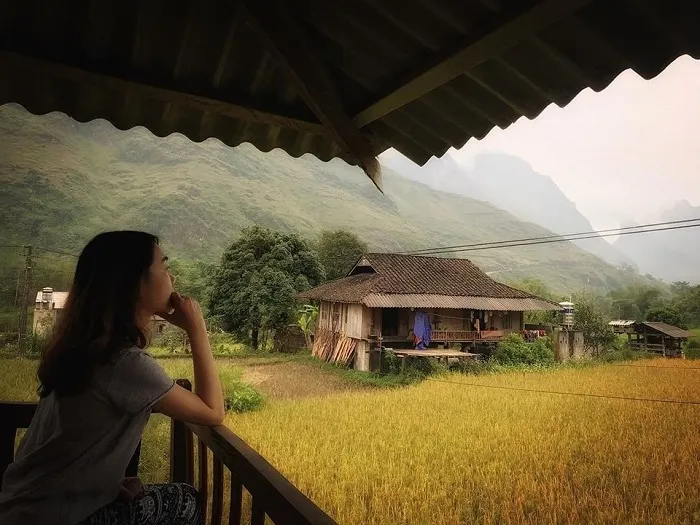
The ideal months is from October to May when the weather is generally mild and suitable for exploration
Timing your visit to Du Gia can significantly enhance your experience, as the region’s climate varies throughout the year.
The ideal months to visit are typically from October to May when the weather is generally mild and suitable for exploration. During this window, travelers can engage in various outdoor activities, from trekking to enjoying the picturesque scenery.
In particular, late October to early November marks the buckwheat flower season, a phenomenon that carpets the surrounding hills with stunning hues of pink and white. The sight of these delicate flowers swaying gently in the breeze is akin to standing in front of a painter’s canvas, where every brushstroke brings forth new beauty. This period is characterized by cool and dry weather, making it perfect for capturing breathtaking photographs amidst blooming landscapes.
From January to March, visitors should prepare for colder temperatures, especially at night. However, the dry climate allows for engaging outdoor adventures during the day.
2. Discover Du Gia in Ha Giang
2.1 Phong Luu Love Market – Du Gia

The love market is steeped in cultural tradition and is a fascinating experience for visitors looking for a deeper connection with local customs
The Phong Luu Love Market in Du Gia is a unique cultural event that reflects the rich traditions of the local ethnic communities. Held Friday night until Saturday during the second week of the third lunar month, this vibrant market is not just a place for trading goods but also a social gathering where young people meet, sing, and express their feelings for one another. The market is filled with traditional music, dance, and colorful attire, creating a lively and festive atmosphere.
For visitors, the Phong Luu Love Market offers a rare opportunity to witness and participate in an age-old tradition that remains an integral part of life in Du Gia.
2.2 Du Gia National Park
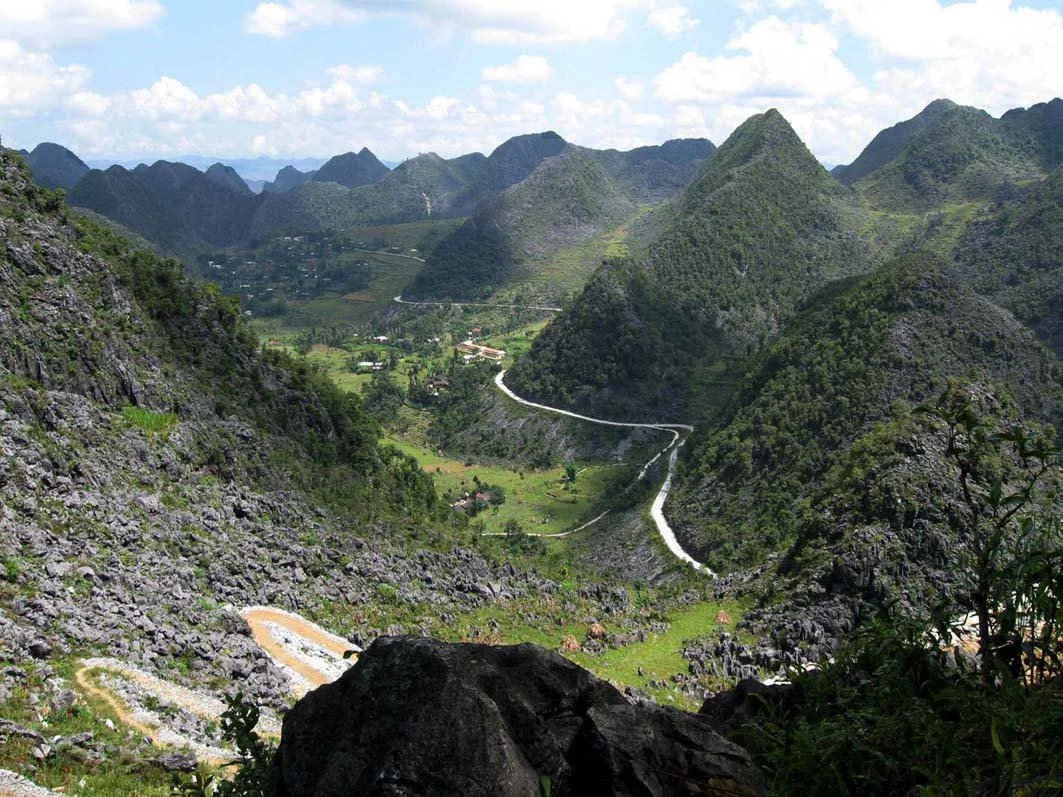
Du Gia National Park is part of Dong Van Karst Plateau Geopark
Du Gia is home to the breathtaking Du Gia National Park, which spans over 15,000 hectares and is part of the Dong Van Karst Plateau Geopark. The park stretches across Yên Minh, Vị Xuyên, and Bắc Mê districts, offering an extraordinary ecosystem with a wide range of flora and fauna.
Why Visit Du Gia National Park:
- Natural Beauty: The park is home to diverse ecosystems and breathtaking vistas. Visitors will find themselves captivated by the dramatic landscapes that include flowing streams, terraced rice fields, and vast mountain ranges that touch the sky. Hiking along the park trails reveals picturesque scenes reminiscent of a watercolor painting.
- Biodiversity: The park acts as a critical habitat for numerous plant and animal species. Birdwatchers and wildlife enthusiasts will find joy in spotting various species that call this park home.
- Outdoor Adventures: With numerous trekking paths, Du Gia National Park is a haven for outdoor lovers. The well-maintained trails cater to different levels of hiking proficiency. From leisurely walks to challenging treks, visitors can explore the lush environment while engaging in activities like birdwatching, camping, or simply soaking in the tranquility of nature.
- Cultural Experiences: Beyond its natural allure, the park is an excellent place to connect with local traditions. Engaging in homestays offers travelers the chance to learn about the customs of the Tay and H’mong peoples while enjoying traditional meals that showcase local ingredients. This intimate interaction adds depth to the visit and enhances appreciation for the local culture.
2.3 Du Gia Stream
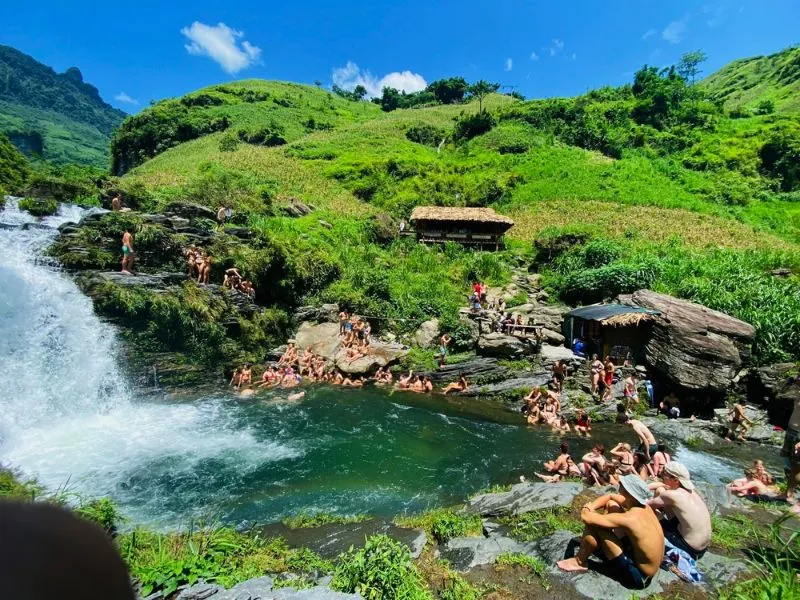
The clear waters and lush green banks create a peaceful environment that invites visitors to relax and enjoy the beauty of nature
Du Gia Stream flows through the picturesque valley, originating from the Nậm Lang River, and serves as one of the region’s notable natural attractions. As you approach the stream, the sound of water gently cascading over smooth stones greets you, creating a sense of peace and tranquility. The pristine waters and lush banks invite visitors to enjoy a moment of reflection, away from the rigors of everyday life.
The stream is not only a retreat for locals escaping the summer heat but also a favorite pitstop for travelers seeking relaxation after hiking in the lush surroundings. The clear, cool water is inviting, with several deeper pools perfect for swimming, taking a refreshing dip, or simply lounging in the delightful embrace of nature. It acts like a balm for the weary soul, washing away the cares of the world as you immerse in the soothing waters.
2.4 Du Gia Villages
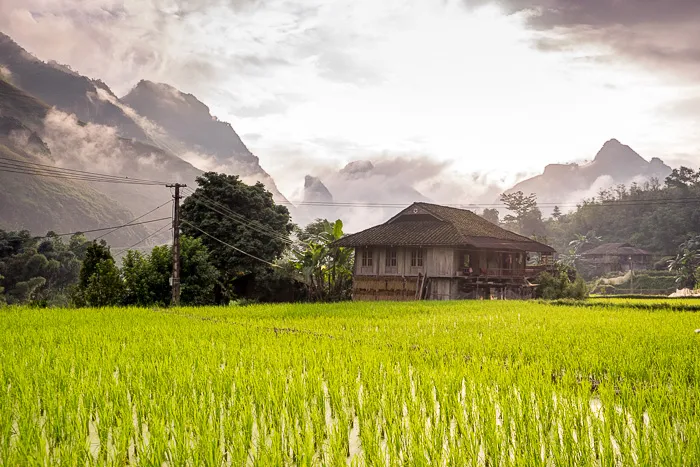
The terraced fields surrounding the villages are a testament to the ingenuity and skill of the local farmers
The Du Gia Villages provide an enchanting glimpse into the traditional lifestyle of the region’s ethnic communities. These picturesque villages, surrounded by breathtaking landscapes of terraced rice fields and rolling mountains, offer a serene escape from the hustle and bustle of modern life.
Each village is characterized by its traditional wooden stilt houses, which are not only functional but also reflect the architectural heritage of the local ethnic groups. The vibrant local markets are a highlight, where visitors can witness the daily life of the villagers and explore a variety of handmade crafts, textiles, and local produce. These markets are not just commercial hubs but also social gathering spots where locals come together to exchange news and celebrate festivals.
Walking through the Du Gia Villages, you’ll encounter friendly locals who are eager to share their culture and traditions.
2.5 Tham Luong Waterfall
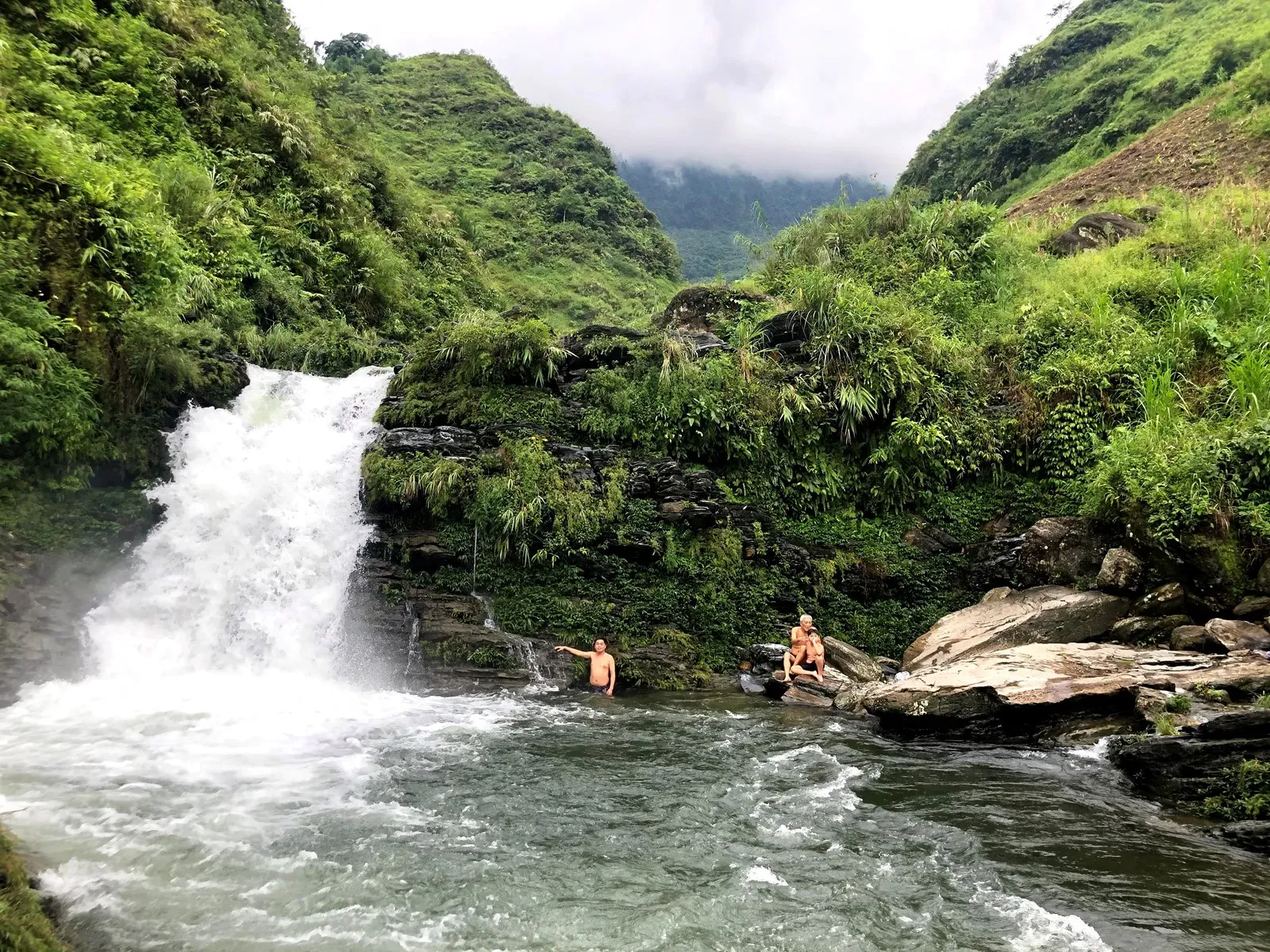
The isolated location of Tham Luong Waterfall makes it an ideal spot for visitors who want to get away from the crowds and enjoy the tranquility of nature
Tham Luong Waterfall is a hidden gem that offers breathtaking natural beauty and tranquility. Nestled amidst lush forests and rugged landscapes, this picturesque waterfall cascades gracefully down rocky cliffs, creating a stunning spectacle that captivates visitors.
The journey to Tham Luong Waterfall is an adventure in itself, with scenic trails that lead through verdant countryside and vibrant local villages. Upon arrival, you’ll be greeted by the sight of crystal-clear waters plunging into a serene pool, surrounded by a lush, green canopy. The sound of the cascading water, combined with the surrounding natural beauty, creates a peaceful retreat from the everyday hustle.
Tham Luong Waterfall is a perfect spot for nature enthusiasts, photographers, and those seeking a serene escape. Its remote location ensures that it remains relatively untouched by mass tourism, allowing visitors to enjoy its beauty in a tranquil setting. Whether you’re looking to take a refreshing dip, enjoy a picnic, or simply marvel at the natural surroundings, Tham Luong Waterfall is a must-visit destination for anyone exploring the Ha Giang region.
3. Best Accommodation in Du Gia
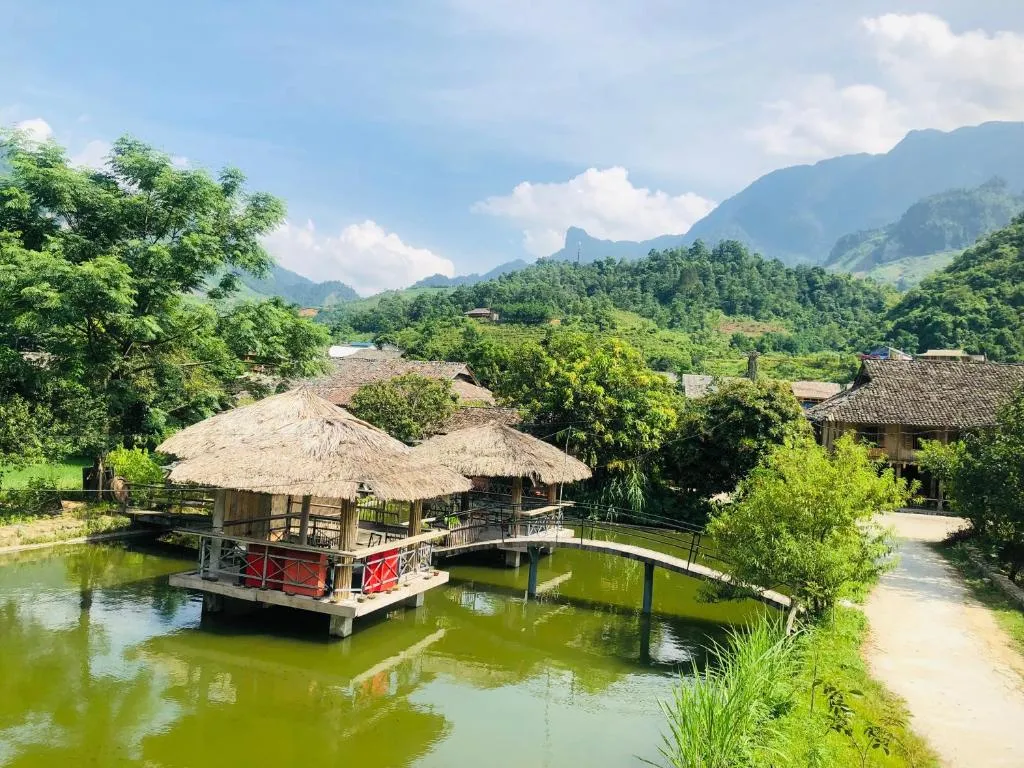
After a long day exploring Ha Giang Loop, you can relax at homestays to immerse yourself in the life of the locals
When visiting Du Gia, choosing the right homestay can greatly enhance your experience. Here are some specific homestays that offer a warm and authentic stay:
- Du Gia Homestay: This popular choice offers traditional stilt houses with comfortable rooms and home-cooked meals. Guests can enjoy the scenic surroundings and interact with the local ethnic communities.
- H’mong House: Known for its authentic experience, H’mong House provides cozy accommodations and a chance to learn about the H’mong culture. The homestay features traditional decor and offers guided tours of the local area.
- Phong Luu Homestay: Located near the Phong Luu Love Market, this homestay provides a unique cultural experience with comfortable lodging and the opportunity to immerse yourself in local traditions.
- Bamboo Homestay: Offering a blend of comfort and traditional charm, Bamboo Homestay provides spacious rooms and a warm atmosphere. The hosts are known for their hospitality and delicious local cuisine.
These homestays offer a genuine taste of life in Du Gia, allowing you to experience the local culture while enjoying comfortable accommodations.
Du Gia, with its serene landscapes, vibrant local culture, and welcoming communities, truly stands out as a hidden gem on the Ha Giang Loop. From the breathtaking terraced rice fields and traditional stilt houses to the lively Phong Luu Love Market and tranquil Tham Luong Waterfall, this charming village offers a rich and immersive experience. Whether you’re exploring the scenic trails, engaging with the friendly locals, or simply relaxing in the natural beauty, Du Gia provides a unique and memorable journey. For more insights and travel tips, visit Karst Plateau.


